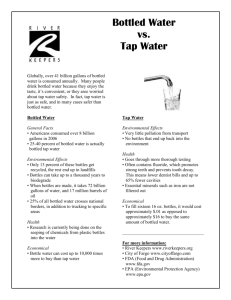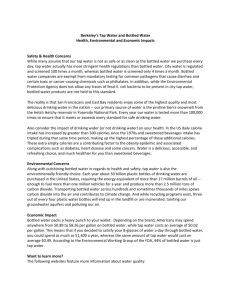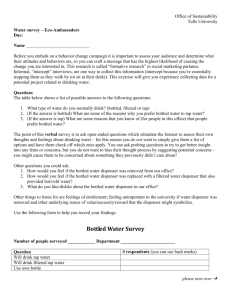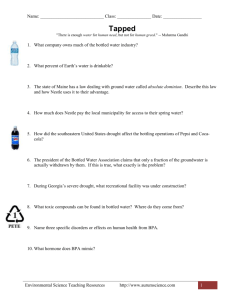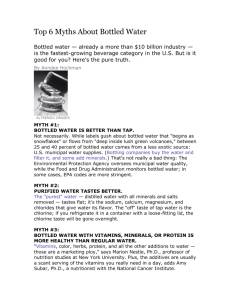Running Head: LAB 2 1 Lab 2: Water Quality and Contamination
advertisement
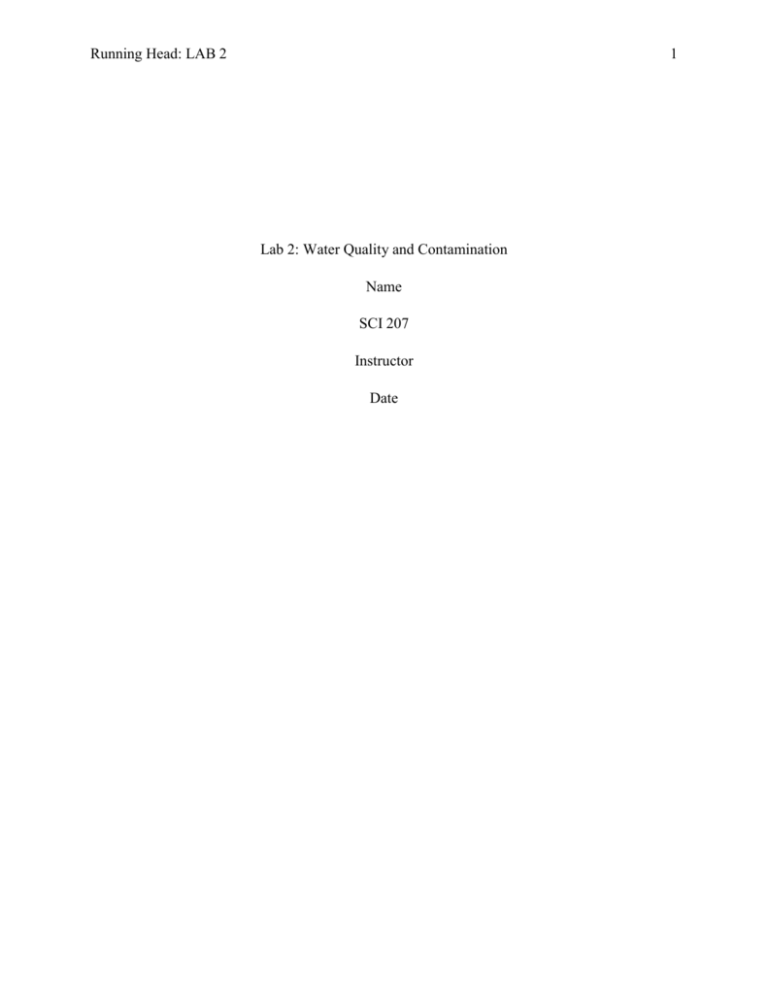
Running Head: LAB 2 1 Lab 2: Water Quality and Contamination Name SCI 207 Instructor Date Running Head: LAB 2 2 Lab 2 - Experiment 1: Effects of Groundwater Contamination Table 1: Water Observations (Smell, Color, Etc.) Beaker Observations 1 To me this is just water, there is no smell. As you pour the oil in the water the oil started to bubble at the top. When stirring 2 the oil turned into smaller bubbles. It looks as if the oil has placed a thick line of film on the water After pouring the vinegar in the water the only change I noticed was that the water seemed to be a shade darker when added it. 3 The water looks like it is clouded some. Other than the smell a person would not be able to tell there has been something added to the water. After pouring in the detergent the water 4 begin to look cloudy and there is a thin layer of bubbles. 5 The water turned a medium brown and it Running Head: LAB 2 3 has small flakes of soil that hascircled around the top of the water. Smells like potting soil. The water and oil mixture seemed to have a “cleaner” look to the water; it had a light 6 brown color. There was still a thin shiny film at the top of the water. The water/vinegar mix had a very light 7 brown color to it but it looked cleaner than the other two. This one has still a light brown color but this seems to have a dark cloud/fog like texture. There also does not seem to have a smell to 8 it. Hypothesis: If I put a mixture of potting soil and oil/vinegar/laundry detergent it will make four different types of dirty water. Post-Lab Questions: 1. Restate your hypothesis. Was it confirmed or denied? How do you know? Running Head: LAB 2 4 If I put a mixture of potting soil and oil/vinegar/laundry detergent it will make four different types of dirty water. Yes, the experiment did confirm my hypothesis since when I added the soil mixture in it did make four dirty types of filthy water. 2. What affects did each of the contaminants have on the water in the experiment? Which contaminant seemed to have the most potent effect on the water? The effects of the contaminated water were that the mixture showed each water type to have a brown color to them. The water type that seemed to have both a surprising and potent effect was the water and soil mixture. I would have thought with using strictly water and potting soil the water turned the darkest brown out of all the other contaminants that I used for the mixture. The vinegar and soil mixture seemed to have cleaner look to them. 3. On a larger scale, what type of affects would these contaminants have on a town’s water source and the people who drank the water? If people were to ingest this contaminated water they might get sick, have birth defects, have trouble having a child, may die, etc. 4. What type of human activity would cause contaminants like oil, acid and detergents to flow into the water supply? On a daily basis humans are dumping waste like oil and acid onto their earth without even realizing it. With drilling for oil they risk the occasional oil spill and if humans are taking the proper care of a landfill site they also risk these contaminates to sink into the Earth’s surface. 5. What other items within your house do you believe could contaminate the water supply if you were to dump them into the ground? There are many things that could contaminate the water supply in my house like; bleach, Running Head: LAB 2 shampoo, body wash/soap, soda, cleaning supplies, etc. 5 Running Head: LAB 2 6 Lab 2 - Experiment 2: Water Treatment Hypothesis: If this dirty water can be treated it will then be clean and drinkable water. Post-Lab Questions 1. Restate your hypothesis. Was it confirmed or denied? How do you know? If this dirty water can be treated it will then be clean and drinkable water. It was confirmed since in the original “dirty” water it was dark brown and smelled of dirt which is npt drinkable. When I filtered through the dirty water it seemed to clean the dirt out of the water and now the water looks like clean water. 2. What are the differences between the “contaminated” water and the “treated” water (look at color, smell, visibility, etc.)? The differences between the two are that the treated water is clear for the most part, it has a cloudy look to it, but it is clear and looks like water. The contaminated one is a dark brown and it smells like potting soil and dirt. All of the potting soil has moved to the top of the water in the beaker. 3. From the introduction to this lab, you know that there are typically five steps involved in the water treatment process. Identify the processes (e.g., coagulation) that were used in this lab and describe how they were performed. You start out with the contaminated water that has not been filtered out or has not had any chemicals added to it, this is many done so air can meet the water and this gives the chemicals and gases to release. I then added Alum to the dirty water since when mixing Alum with the dirty water it allows all the big particles to “stick” to the Alum and then pushes all of these particles to the bottom of the water. The dirty water is then put through a filter of sand, charcoal, and gravel in order for any of the smaller particles to stick to them and makes the water clean and free of any other particle. After I did all this I then had to add Running Head: LAB 2 7 a few drops of bleach so I could disinfect the water from any other dirt particle. Lab 2 - Experiment 3: Drinking Water Quality Table 2: Ammonia Test Results Water Sample Test Results Tap Water 0 Dasani® Bottled Water 0 Fiji® Bottled Water 0 Table 3: Chloride Test Results Water Sample Test Results Tap Water 0 Dasani® Bottled Water 500 Fiji® Bottled Water 500 Table 4: 4 in 1 Test Results Water Sample pH Total Alkalinity Total Chlorine Total Hardness Tap Water 4 80 0.2 0 - Soft 3 120 0 50 7 80 0.2 50 Dasani® Bottled Water Fiji® Bottled Water Table 5: Phosphate Test Results Running Head: LAB 2 8 Water Sample Test Results Tap Water 25 Dasani® Bottled Water 10 Fiji® Bottled Water 100 Table 6: Iron Test Results Water Sample Test Results Tap Water 0.3 Dasani® Bottled Water 0 Fiji® Bottled Water 0.15 Hypothesis: If all three types of water are tested tap water will come back to be the dirtiest water and Fiji Water will come back to be the cleanest water type. Post-Lab Questions 1. Restate your hypothesis. Was it confirmed or denied? How do you know? If all three types of water are tested tap water will come back to be the dirtiest water and Fiji Water will come back to be the cleanest water type. The hypothesis that I came up with was proven wrong since the Fiji water came back with having the most chemicals and the tap water came back to be the cleanest. Running Head: LAB 2 9 2. After comparing the results of tap water and bottled water, what major differences, if any, do you notice between the two? The differences that have stuck out to me the most is the fact that the tap water came back to being soft but the two bottled waters came back to be hard. Tap water seems to be significantly lower in the chemicals and the bottled water had tons of chemicals in them. 3. From your results, do you believe that bottled water is a healthier alternative when compared to tap water? Why or why not? No, tap water is obviously healthier to consume then bottled water since there are less chemicals in it vs. the bottled water. I have also thought tap water was one of the worst things you could consume since I assumed tap water was dirty since there aren’t as many filters like bottled water but, I was clearly mistaken. Running Head: LAB 2 10 References Esceincelabs.com (2012). Introduction to Science. Retrieved from: http://vizedhtmlcontent.next.ecollege.com/pub/content/dae1791b-05ac-49569b43-e43262bbce1c/SCI207.W1.Laboratory.pdf
